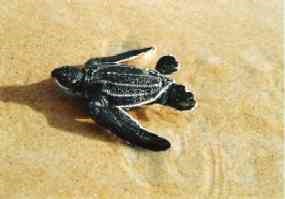
Paula Baldassin Common Name: Leatherback - named for its unique shell which is composed of a layer of thin, tough, rubbery skin Scientific Name: Dermochelys coriacea Description: The highly specialized leatherback is the largest of the sea turtles and can reach the size of a Volkswagen! Leatherbacks are have one of the longest migrations in the world and ventures into the cold waters of the Arctic to hunt large jellyfish (their primary food source). Hatchlings are marked be white stripes and the front flippers are as long as the shell. Adults have a smooth, scaleless black to brown shell raised into seven narrow ridges that extend the length of the back. The limbs, head and back are often marked by white, pink or blue blotches. Unlike other sea turtles, the leatherback has no claws on its flippers. The coloration of the leatherback, dark above and lighter below. Size: Diet: Leatherbacks have scissor-like jaws that are shaped like a W. Their jaws are made of soft skin, and can be damaged by anything other than a diet of soft-bodied animals, so they feed almost exclusively on jellyfish. Jellyfish are an energy-poor food source because they are mostly water, so it is remarkable that a large, active animal can live on this diet. Many leatherbacks die from ingesting plastic debris mistaken for jellyfish. Habitat: Leatherbacks are primarily found in the open ocean, as far north as Alaska and as far south as the southern tip of Africa. Occasionally enters shallow waters just offshore and may enter bays and estuaries. Known to be active in water below 40 degrees Fahrenheit and is considered to be the only reptile known to remain active at such low temperatures. Nesting: Leatherbacks nest at intervals of 2 to 3 years, but recent research has indicated they can nest every year based on their environment and how healthy they are. These turtles can nest between 6 to 9 times per season, with an average of 10 days between nesting. Eggs will incubate in the sand for 50 to 78 days before hatching. Unlike other sea turtle species, leatherback females may change nesting beaches, though they tend to stay in the same region. The Cape Hatteras National Seashore is at the extreme northern limit for nesting (with only a handful of nests over the last twenty years). Range: Leatherbacks are the most widely distributed of all sea turtles. Found world wide, with the largest north and south range of all sea turtle species. With its streamlined body shape and the powerful front flippers, a leatherback can swim thousands of miles over open ocean and against fast currents. Status: Of all the species of sea turtles, leatherbacks are generally thought to be the ones most at risk for extinction despite their global population. Threats include loss of nesting habitat, poaching, fisheries interactions, trash ingestion, global climate change, and others. Population Estimate: around 35,860 nesting females (male population numbers are unknown). |
Last updated: August 30, 2023
